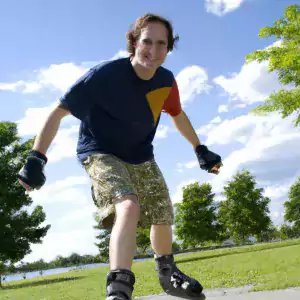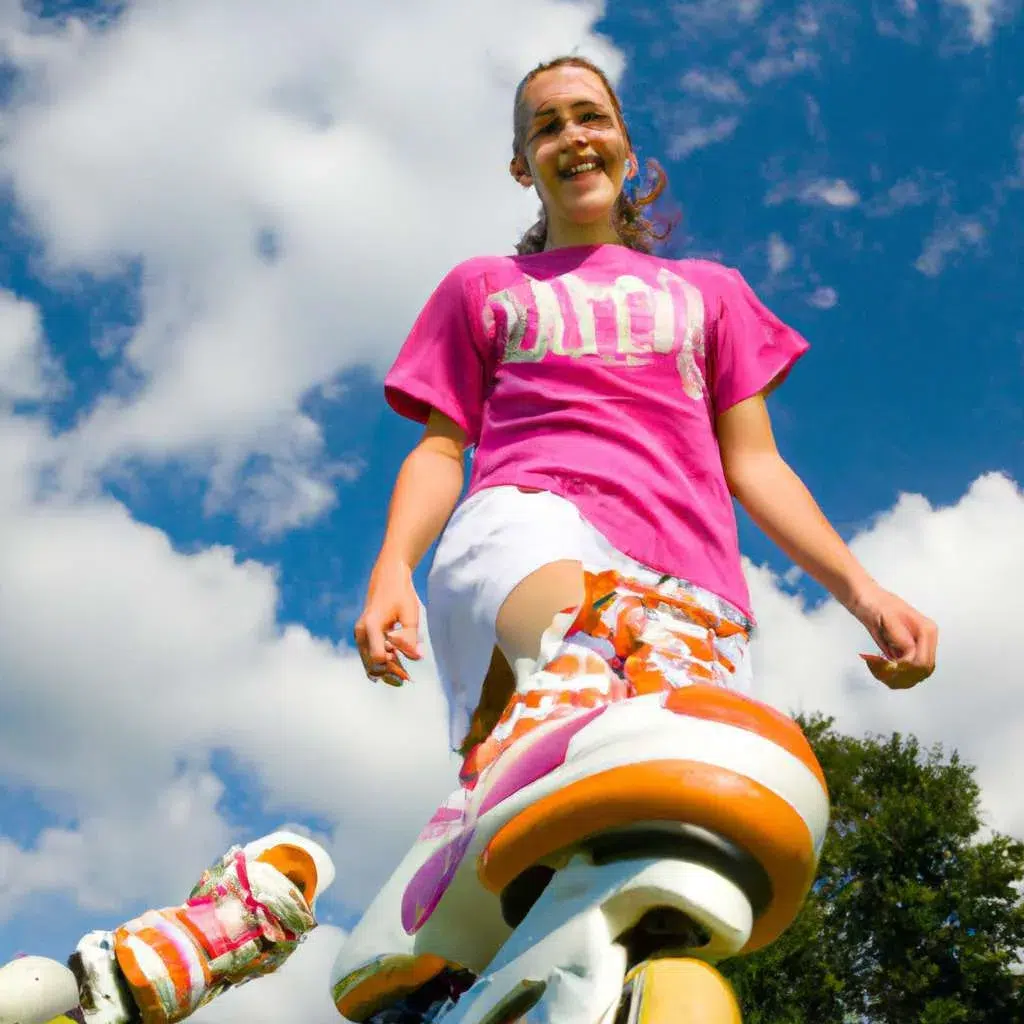Table of Contents
Table of Contents
Rollerblading, also known as inline skating, is a popular form of exercise that provides numerous benefits for the body. It is a low-impact activity that can be enjoyed by people of all ages and fitness levels, making it an excellent choice for those looking to stay active and healthy.
Rollerblading can be done indoors or outdoors, making it a versatile workout option.
One of the most significant benefits of rollerblading is its ability to provide an effective cardiovascular workout. Rollerblading is an aerobic activity that can help improve heart health and increase endurance.
In addition to improving cardiovascular health, rollerblading also works for several different muscle groups in the body.
Skating helps to strengthen the lower body, including the legs, hips, and glutes. It also engages the core muscles, which are essential for maintaining balance and stability.
Rollerblading can also improve upper body strength and mobility due to the pumping and swinging motion of the arms.
Roller Derby Firestar Youth Skates for Girls, Boys, Beginners, Kids
(as of 07/25/2024 14:17 GMT +01:00 - More infoProduct prices and availability are accurate as of the date/time indicated and are subject to change. Any price and availability information displayed on [relevant Amazon Site(s), as applicable] at the time of purchase will apply to the purchase of this product.)Benefits of Rollerblading Workout
Cardiovascular Benefits
Rollerblading is a great way to improve your cardiovascular fitness. It increases your heart rate, which strengthens your heart and lungs.
According to Livestrong, rollerblading burns between 210 and 311 calories per 30 minutes, depending on your body weight. This makes it an effective way to burn calories and lose weight, which can also improve your cardiovascular health.
Muscular Benefits
Rollerblading works all of the muscles in your legs and hips, including your quadriceps, hamstrings, glutes, and calves.
It also strengthens your core muscles, which can improve your balance and stability. According to Marathon Handbook, rollerblading can help you develop long, lean muscles, which can improve your overall body composition.
Joint Benefits
Rollerblading is a low-impact exercise, which means it puts less stress on your joints than high-impact exercises like running. This makes it a great option for people who have joint pain or injuries.
According to Nike, rollerblading can also help improve your joint flexibility and range of motion.
Roller Derby Aerio Women's Inline Skates
(as of 07/25/2024 14:17 GMT +01:00 - More infoProduct prices and availability are accurate as of the date/time indicated and are subject to change. Any price and availability information displayed on [relevant Amazon Site(s), as applicable] at the time of purchase will apply to the purchase of this product.)Calorie Burning Benefits
Rollerblading is a great way to burn calories and lose weight. According to Marathon Handbook, rollerblading can burn up to 10 calories per minute, which is comparable to running or cycling.
This makes it an effective way to burn calories and lose weight, which can also improve your overall health and fitness.
Preparation for Rollerblading Workout
Rollerblading is a fun and effective way to get a full-body workout. However, before you hit the pavement, it’s important to prepare properly to avoid injuries and maximize your performance.
Here are a few tips to help you prepare for your rollerblading workout:
Choosing the Right Gear

One of the most important aspects of preparing for a rollerblading workout is choosing the right gear.
Make sure you have a pair of rollerblades that fit properly and provide adequate support for your feet and ankles.
You should also wear a helmet and protective gear such as knee and elbow pads to prevent injuries in case of falls.
It’s also important to consider the surface you’ll be rollerblading on. If you’ll be skating on rough or uneven surfaces, you may want to choose rollerblades with larger wheels that can handle bumps and cracks better.
WayEee Kids Bike Helmet Set Skateboard Knee Pads, Helmet Pad Set Protective Gear Set Adjustable for Girls Kids 3-10 Helmet Elbow Pads Wrist Guards for Sport Cycling Bike Roller Skating Scooter
(as of 07/25/2024 14:17 GMT +01:00 - More infoProduct prices and availability are accurate as of the date/time indicated and are subject to change. Any price and availability information displayed on [relevant Amazon Site(s), as applicable] at the time of purchase will apply to the purchase of this product.)Warming Up
Before you start your rollerblading workout, it’s important to warm up properly to prevent injuries and improve your performance. A good warm-up should include a few minutes of light cardio such as jogging or jumping jacks to get your heart rate up and your blood flowing.
You can also do some dynamic stretching exercises such as leg swings and arm circles to help loosen up your muscles and joints. This will help you move more efficiently and reduce the risk of injury.
Stretching
After your rollerblading workout, it’s important to stretch to prevent muscle soreness and improve your flexibility. Static stretching exercises such as hamstring stretches and quad stretches can help lengthen your muscles and improve your range of motion.
It’s important to hold each stretch for at least 30 seconds and avoid bouncing, which can cause injury. Remember to breathe deeply and relax into each stretch to get the most benefit.
NEMONE Mermaid 4 Size Adjustable Light up Roller Skates for Girls, Purple Blue Skates for Toddlers, Beginner Kids Roller Skates Indoor Outdoor
(as of 07/25/2024 14:17 GMT +01:00 - More infoProduct prices and availability are accurate as of the date/time indicated and are subject to change. Any price and availability information displayed on [relevant Amazon Site(s), as applicable] at the time of purchase will apply to the purchase of this product.)Rollerblading Techniques
Basic Techniques
Before attempting any advanced techniques, it is essential to master the basics of rollerblading. Here are some basic techniques that every beginner should learn:
- Standing upright with feet shoulder-width apart
- Learning to balance on one foot at a time
- Learning to stride forward with one foot at a time
- Learning to stop using the brake on the back of the skate
Once you have mastered these basic techniques, you can move on to more advanced techniques.
Advanced Techniques
Advanced rollerblading techniques require more skill and practice. Here are some advanced techniques to try:
| Technique | Description |
|---|---|
| Crossover | One foot crosses over the other foot while skating. This technique is used to turn quickly. |
| Jumping | Jumping while rollerblading requires balance and control. It is important to start with small jumps and gradually increase the height. |
| Backward skating | Skating backward requires balance and control. It is important to start slowly and gradually increase speed. |
| Parallel turn | This technique is used to make a quick turn while maintaining speed. It involves turning both feet in the same direction. |
Remember to always wear protective gear when attempting advanced techniques. It is also important to practice in a safe environment with plenty of space.
Knee Pads for Kids Kneepads and Elbow Pads Toddler Protective Gear Set Kids Elbow Pads and Knee Pads for Girls Boys with Wrist Guards 3 in 1 for Skating Cycling Bike Rollerblading Scooter
(as of 07/25/2024 14:17 GMT +01:00 - More infoProduct prices and availability are accurate as of the date/time indicated and are subject to change. Any price and availability information displayed on [relevant Amazon Site(s), as applicable] at the time of purchase will apply to the purchase of this product.)Safety Tips
Rollerblading is a fun and exhilarating workout, but it’s important to take safety seriously. Here are some tips to help you stay safe while enjoying your rollerblading workout:
- Wear Protective Gear: Always wear a helmet, wrist guards, elbow pads, and knee pads. They can help prevent serious injuries in the event of a fall.
- Check Your Equipment: Before you start skating, check your equipment to make sure everything is in good working order. Ensure that your wheels are properly tightened and that your brakes are functioning correctly.
- Stay Visible: Wear brightly coloured or reflective clothing so that you can be easily seen by drivers and other people on the road. If you’re skating at night, make sure to wear reflective gear and use lights to increase your visibility.
- Choose Safe Routes: Stick to designated bike paths, parks, or other areas that are safe for rollerblading. Avoid busy streets or areas with heavy traffic.
- Stay Alert: Keep an eye out for potential hazards, such as potholes, rocks, or uneven pavement. Always be aware of your surroundings and be prepared to react quickly if necessary.
- Practice Proper Technique: Learn the proper technique for stopping, turning, and manoeuvring on your rollerblades. Taking lessons can help you improve your technique and prevent falls.
Conclusion
Rollerblading is a great workout that offers a wide range of benefits for people of all ages and fitness levels. It can help you get your heart rate up, build muscle, and improve your balance and coordination. Plus, it’s a low-impact exercise that is easy on your joints, making it a great option for people who are recovering from injuries or have joint pain.
One of the best things about rollerblading is that it’s a fun and enjoyable activity that you can do alone or with friends. You can explore your local park or neighbourhood while getting a great workout at the same time. And because it’s a full-body exercise, you’ll be working multiple muscle groups at once, which can help you burn more calories and get in better shape.
However, it’s important to remember to wear protective gear, such as a helmet, knee pads, and wrist guards, to stay safe while rollerblading. And if you’re new to the sport, it’s a good idea to start off slow and gradually build up your endurance and skill level.







